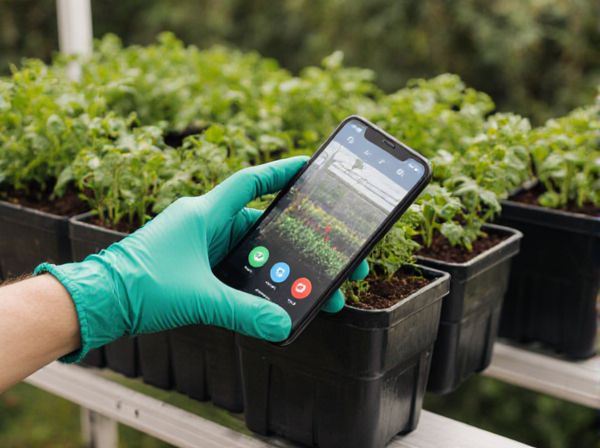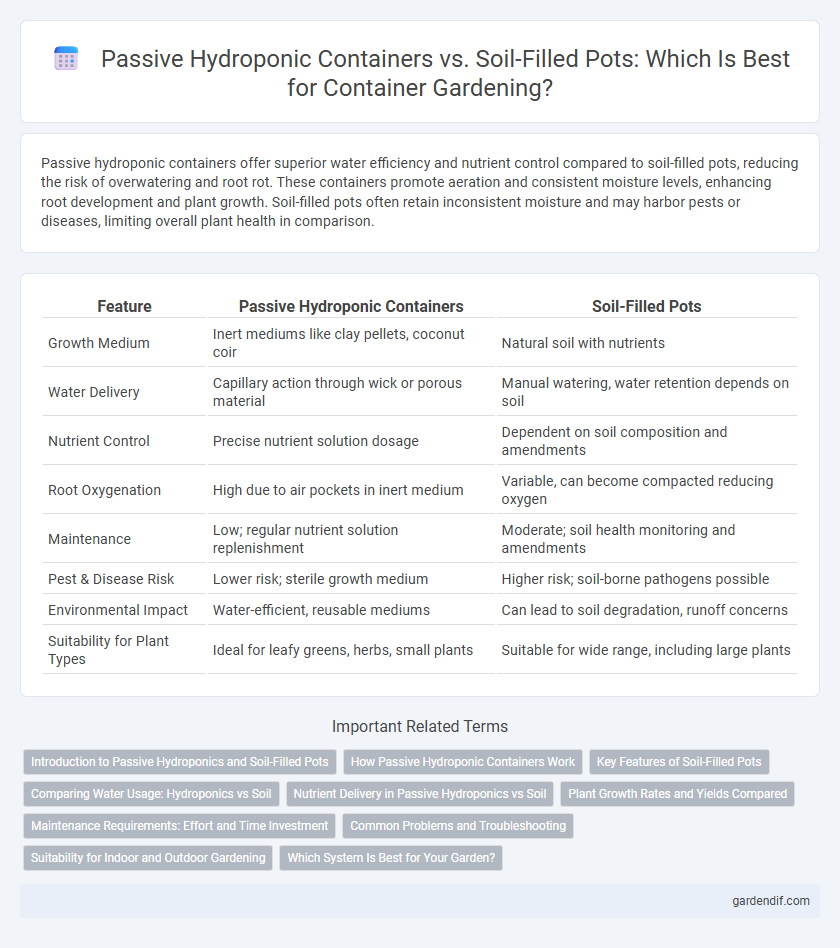
Passive hydroponic containers vs soil-filled pots Illustration
Passive hydroponic containers offer superior water efficiency and nutrient control compared to soil-filled pots, reducing the risk of overwatering and root rot. These containers promote aeration and consistent moisture levels, enhancing root development and plant growth. Soil-filled pots often retain inconsistent moisture and may harbor pests or diseases, limiting overall plant health in comparison.
Table of Comparison
| Feature | Passive Hydroponic Containers | Soil-Filled Pots |
|---|---|---|
| Growth Medium | Inert mediums like clay pellets, coconut coir | Natural soil with nutrients |
| Water Delivery | Capillary action through wick or porous material | Manual watering, water retention depends on soil |
| Nutrient Control | Precise nutrient solution dosage | Dependent on soil composition and amendments |
| Root Oxygenation | High due to air pockets in inert medium | Variable, can become compacted reducing oxygen |
| Maintenance | Low; regular nutrient solution replenishment | Moderate; soil health monitoring and amendments |
| Pest & Disease Risk | Lower risk; sterile growth medium | Higher risk; soil-borne pathogens possible |
| Environmental Impact | Water-efficient, reusable mediums | Can lead to soil degradation, runoff concerns |
| Suitability for Plant Types | Ideal for leafy greens, herbs, small plants | Suitable for wide range, including large plants |
Introduction to Passive Hydroponics and Soil-Filled Pots
Passive hydroponic containers use a water reservoir to provide nutrients directly to plant roots through capillary action, promoting efficient hydration and reducing soil-borne diseases. Soil-filled pots rely on traditional soil mediums that retain nutrients and moisture but often require frequent watering and are susceptible to pests and root rot. Understanding the differences in nutrient delivery and maintenance between passive hydroponics and soil pots is crucial for optimizing plant growth in various horticultural settings.
How Passive Hydroponic Containers Work
Passive hydroponic containers work by using a water reservoir and a wick or capillary mat to deliver moisture and nutrients directly to plant roots without soil. This system maintains consistent hydration and nutrient supply, reducing the risk of overwatering and root rot common in soil-filled pots. Passive hydroponics promotes better oxygenation, leading to faster root growth and healthier plants compared to traditional soil cultivation.
Key Features of Soil-Filled Pots
Soil-filled pots offer natural aeration and moisture retention through the organic composition of the soil, promoting healthy root growth. Their ability to support a wide range of plants with varied nutrient requirements makes them versatile for gardening applications. Unlike passive hydroponic containers, soil-filled pots rely on traditional soil microbes and organic matter to sustain plant health and ecosystem balance.
Comparing Water Usage: Hydroponics vs Soil
Passive hydroponic containers use significantly less water than soil-filled pots by recirculating nutrient solutions and minimizing evaporation losses. Soil-filled pots often require frequent watering due to higher water absorption and runoff, leading to inefficient water use. Hydroponic systems optimize water retention and delivery directly to plant roots, resulting in up to 90% water savings compared to traditional soil gardening.
Nutrient Delivery in Passive Hydroponics vs Soil
Passive hydroponic containers deliver nutrients directly through a water-saturated medium, ensuring consistent availability of oxygen and minerals to plant roots, which enhances nutrient uptake efficiency. Soil-filled pots rely on nutrient decomposition and microbial activity, leading to slower and less predictable nutrient availability. The controlled nutrient delivery in passive hydroponics reduces nutrient loss and promotes faster, healthier plant growth compared to traditional soil pots.
Plant Growth Rates and Yields Compared
Passive hydroponic containers provide higher oxygen availability to plant roots compared to soil-filled pots, resulting in faster plant growth rates and increased yields. Enhanced nutrient absorption in passive hydroponics supports more efficient photosynthesis and biomass production than traditional soil mediums. Studies show hydroponic systems can boost crop yields by up to 30% while reducing growth cycle duration significantly when compared to soil cultivation.
Maintenance Requirements: Effort and Time Investment
Passive hydroponic containers require less frequent watering and nutrient monitoring compared to soil-filled pots, significantly reducing maintenance time. These systems minimize soil-related issues such as pests, diseases, and root rot, lowering the effort needed for plant care. Soil-filled pots demand regular watering, fertilizing, and soil aeration, increasing both the labor and attention required to maintain plant health.
Common Problems and Troubleshooting
Passive hydroponic containers often face issues such as root rot due to poor oxygenation and nutrient imbalances caused by stagnant water, whereas soil-filled pots commonly struggle with overwatering and soil compaction leading to root suffocation. Troubleshooting passive hydroponic systems requires regular monitoring of water levels, improving aeration with wick systems, and ensuring proper nutrient solution cycling. In soil pots, remedies include adjusting watering schedules, using well-draining soil mixes, and loosening compacted soil to enhance root health and prevent fungal growth.
Suitability for Indoor and Outdoor Gardening
Passive hydroponic containers offer better suitability for indoor gardening due to their controlled water and nutrient delivery, reducing the risk of overwatering and soil-borne pests common in soil-filled pots. Soil-filled pots remain preferred for outdoor gardening as they allow natural soil ecosystems to support plant growth and provide greater insulation against temperature fluctuations. Both container types can be optimized for specific environments, but passive hydroponics excels in space-limited indoor settings with consistent plant hydration needs.
Which System Is Best for Your Garden?
Passive hydroponic containers use a water reservoir and wick system to deliver nutrients directly to plant roots, promoting faster growth and efficient water use compared to soil-filled pots. Soil-filled pots provide natural microbial activity and better support for certain plant species, making them ideal for traditional gardening preferences and cost-effectiveness. Choosing the best system depends on your plant types, maintenance preferences, and water availability, with passive hydroponics excelling in controlled environments and soil pots favored for ease of use and biodiversity.
Passive hydroponic containers vs soil-filled pots Infographic

 gardendif.com
gardendif.com